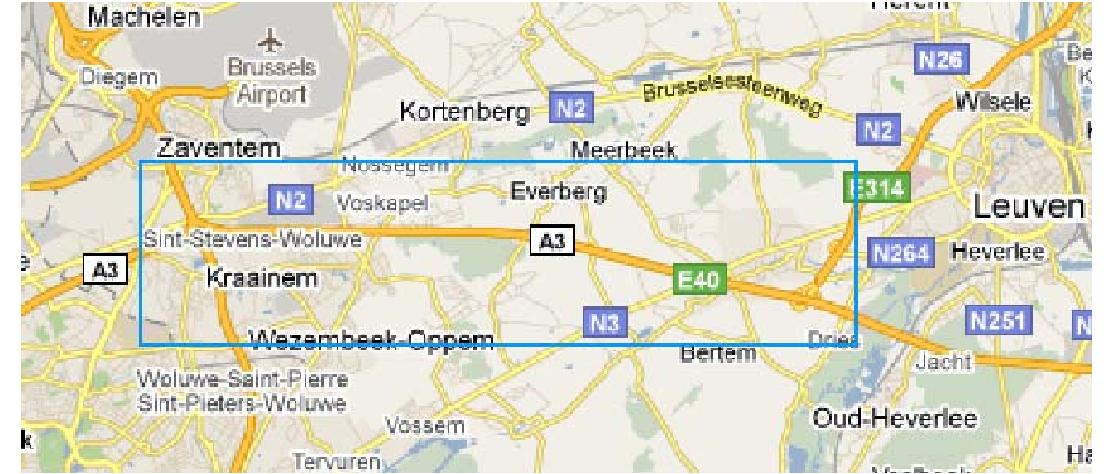Impact Analysis of commuting by motorcycle
Here are the results of the survey
Following on from our article about the impact of motorcycling on traffic congestion here, for your edification, are some facts and figures gathered from a European traffic study.

Study Area
The EU report entitled “Commuting by Motorcycle: Impact Analysis” was the study of a motorway between Leuven and Brussels. The traffic flow was analysed under existing conditions and then under a 10% ‘modal shift’ from cars to motorcycles using an LTM (Link Transmission Model) to show the evolution of traffic in 10 minute intervals. Obviously various tests were undertaken and medians used to project what the ‘average’ commuting day would be like traffic wise (which for the purpose of saving brain power we will leave out - suffice to say, all factors were considered). The roads were studied between 6.30am and 9.30am in both ‘existing’ and ‘modal shift’ conditions.
Stage One - existing road conditions
Under existing road conditions it was found that 0.9% of the vehicles on the road were motorcycles, 82.5% were cars, and the rest were vans or buses etc.
The image below shows the build up of traffic during the morning rush hour under existing road conditions (with red being heavily congested, yellow being mildly congested and green congestion free).
By 7.20am and under existing conditions the roads were heavily congested. They remained so until an hour later when congestion levels started to die down...

Existing traffic congestion at 7.30am
At 9.10 the level of congestion had returned to the same as at 6.30am, signalling the end of the morning rush hour.
Stage Two – Modal shift - If 10% of cars were replaced by motorcycles
Congestion levels reached their highest at 7.30am and stayed the same until 8.10 when they started to decrease.

How the traffic congestion would look at 7.30am if 10% of cars were replaced with motorcycles
By 8.30am the roads were at a normal level of congestion, the same as at 6.30am. Note that the rush “hour” was 40 minutes shorter than during ‘existing conditions’, and the intensity of the congestion was significantly lower. Indeed, the report states that travel time peaked at 20 minutes during existing conditions but at 12 minutes during the modal shift. All this indicates that Kenward may have been right in his claims that increasing the number of motorcycles on the roads would inevitably decrease congestion.
The tests do show a significant easing of congestion due to an increase in motorcycles on the roads but this, they claim, can only be relevant to similar, rush hour conditions. During rush hour the roads are often packed with stationary cars, with motorcycles able to filter past the them in between the lanes. During busier times, and on roads that have extreme congestion or do not have lanes, being on a motorcycle may not get you anywhere, any faster. Likewise, if there is little to no traffic and things are running smoothly, then it is likely that the cars will be a similar stretch apart from each other as motorcycles would be, and cars (being able to carry whole families) may actually take up less space as a whole.
All factors considered, having more motorcycles on the road did ease congestion during test conditions which were designed to represent the average rush hour morning. The report states that there was a total reduction in ‘lost vehicle hours’ - the difference in travel time during congested and free flowing traffic – by 64%, an incredible reduction for only a 10% modal shift. Indeed, they claim that in a 25% modal shift, congestion would be completely eliminated! The report even takes into account the fact that if a previously busy road becomes less so then other drivers (who may have previously taken a different route to avoid congestion) would possibly start using the road again. In fact, if you include all of their factors such as vehicle and maintenance costs, fuel, road tax etc, then lost vehicle hours would be reduced to 40% and not 64%, which is still a dramatic change!
‘What about the emissions?’ I hear you ask. After all, Kenward did claim that increasing the number of motorcycles on the road would lower emissions. The report states that the external emission cost of a motorcycle is 21% lower than that of an average car. A 6% reduction in emissions is noted during the modal shift scenario. This is, again, obviously dependant on the number of people travelling in one car at a time (if each passenger were to ride their own motorcycle then the overall emissions would be higher). It is highly unusual though to witness a car completely full of people during a busy time on the roads as many families now own two cars rather than one.
The only thing it seemed that the EU report left out was the safety issue, but, like the rest of Kenward’s claims during the MCIA convention, its validity all depends on a number of factors. What we can know for sure is that increasing the number of motorcycles on a road during a normal European rush hour does help to ease congestion and, going by the average, will lower emissions and fuel costs. These should be a good enough reasons for you to feel just a little bit smug as you filter past car after car stuck in traffic on your way to work tomorrow, and you're doing your bit for the planet as well!
.
Any comments or thoughts to add email us at:
[email protected] or comment on Twitter or Facebook


